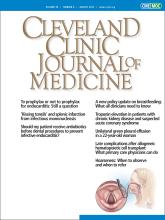ABSTRACT
The terms hoarseness and dysphonia are used interchangeably, and both describe a type of altered vocal quality affecting one-third of patients. While hoarseness may be secondary to benign conditions such as reflux or viral laryngitis, it may suggest benign or malignant vocal-fold pathology. It is important for caregivers to know how to evaluate, treat, and when to refer patients for direct visualization via laryngoscopy. In this article, we review basic laryngeal anatomy and function, symptoms of vocal-fold pathology, and current guidelines from the American Academy of Otolaryngology–Head and Neck Surgery on the diagnosis and treatment of dysphonia, including patient referral.
- Copyright © 2023 The Cleveland Clinic Foundation. All Rights Reserved.
- Ellen L. Ferraro, MD⇑
- Address:
Ellen L. Ferraro, MD, Department of Otolaryngology, A71, Cleveland Clinic, 9500 Euclid Avenue, Cleveland, OH 44195; ferrare{at}ccf.org
- Rebecca Chota Nelson, MD
- Paul C. Bryson, MD, MBA
ABSTRACT
The terms hoarseness and dysphonia are used interchangeably, and both describe a type of altered vocal quality affecting one-third of patients. While hoarseness may be secondary to benign conditions such as reflux or viral laryngitis, it may suggest benign or malignant vocal-fold pathology. It is important for caregivers to know how to evaluate, treat, and when to refer patients for direct visualization via laryngoscopy. In this article, we review basic laryngeal anatomy and function, symptoms of vocal-fold pathology, and current guidelines from the American Academy of Otolaryngology–Head and Neck Surgery on the diagnosis and treatment of dysphonia, including patient referral.
- Copyright © 2023 The Cleveland Clinic Foundation. All Rights Reserved.






